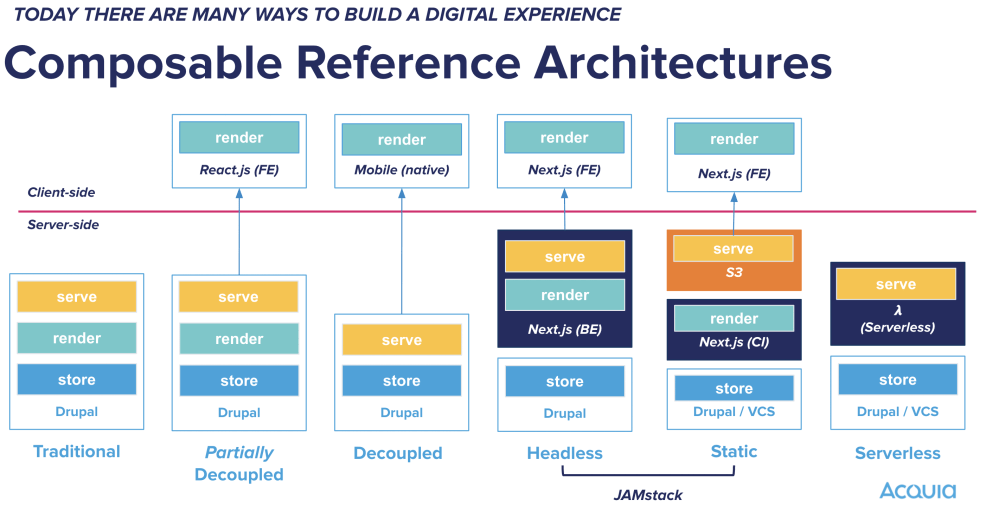Modern organizations produce digital experiences for a growing number of channels and devices, forcing organizations to rethink how they create, repurpose, and reuse content. Businesses need to eliminate content, data, and organizational silos and find new ways to repackage and serve content everywhere their customers live.
Enter the hybrid CMS, an agile, composable approach to content management.
Our new model is a hybrid content management system (CMS) that unites both marketing-powered experiences and developer-driven innovation. But before we dive into what capabilities a true hybrid CMS requires, let’s look at both the benefits and shortcomings of other common CMS frameworks.

Traditional CMS: Scalability with limited room for innovation
Traditional or coupled CMS models function as a monolithic architecture that join the back end (data layers) as well as the front end (presentation layer) of different content types. This approach best suits a world where content is primarily web-based and made for standalone digital applications.
A traditional CMS allows content creators to create, manage, and publish content from the back end while providing a content delivery presentation layer, typically as pre-structured web page templates.
However, the growth of digital channels and interfaces made possible by the Internet of Things (IoT) has made such rigid content architecture antiquated. Digital experiences aren’t just happening on websites; they’re occurring on mobile applications and digital signage to conversational interfaces and games. Each of these touchpoints requires relevant content suited to its unique context.
Traditional solutions do offer strong scalability and security, but they can be difficult to integrate with new channels or tools in your tech stack, leading to frustrating vendor lock-in that doesn’t allow businesses to evolve with the market.
The need to deliver on-demand content across a number of digital channels has led to the rapid rise of the headless CMS model.
Headless CMS: Freedom with added technical complexity
A headless CMS offers back-end CMS functionality via a decoupled architecture independent from a front-end solution. It promises total freedom over how and where content is delivered through API endpoints, opening up endless possibilities for the front end. A headless CMS delivers content via APIs to display content across any device or interface, but while that approach may appear to unlock all the freedoms that a traditional model lacks, organizations also face unique challenges when implementing a headless-only approach.
Headless solutions require significantly more technical expertise to manage multiple API calls. With a decoupled approach, marketers lack the flexibility to manage and customize content on the front end once it’s been built. Marketers can’t make changes to the layout or add a new button or content block without a front-end developer to manage the code.
On the developer side, this means spending more time maintaining and managing content rather than investing in valuable projects that propel an organization’s digital experience forward. This developer-centric model also makes it challenging for marketers to connect customer experiences across channels, such as reusing top performing and relevant content to a decoupled mobile app and traditional e-commerce web page. While a headless CMS makes multichannel content delivery possible, omnichannel customer experiences are still a challenge. The result? Disconnected customer experiences.
The best approach: A hybrid CMS
Experts at Gartner believe a hybrid approach to content management offers more advantages than either coupled or headless-only CMS solutions: “The solution can be used for both traditional WCM [web content management] (coupled or decoupled) and for headless use cases using APIs with other presentation layers. This can appeal to organizations with use cases for both headless and coupled WCM.”
In other words, you can have it all.
Hybrid CMS: Best of both worlds for flexibility at scale
If a solution is difficult to use, marketers and other business units will go rogue, finding workaround solutions that introduce site sprawl as well as security and governance issues. Marketing teams may even turn to running a traditional CMS alongside their decoupled architecture, leading to increased complexity due to managing multiple applications.
Fortunately, there’s a third approach that provides the best of both worlds: A hybrid CMS (also referred to as a progressively decoupled CMS) allows business users to build and update digital experiences while simultaneously providing the flexibility of decoupled architectures for omnichannel delivery. It also offers all users flexibility, ease of use, connectivity, and security and governance at scale.
As an open source content management framework for content and data, Drupal is the leading CMS choice for organizations that require both agility and resilience in designing digital experiences. Drupal supports a hybrid approach by retaining its front-end editorial capabilities while its back end serves as an API-based repository.
To ensure users can quickly design and launch sites for projects of all sizes, we launched Acquia CMS Starter Kits for Drupal, a collection of trusted and best-in-class Drupal modules curated and maintained by Acquia to accelerate new application builds. Each of the Starter Kits provides an accelerated starting point depending on your project or use case, whether it's enabling all users to create content with low-code site building or building a new headless application. The Starter Kits support both structured and unstructured content, meaning they can be used to support both pre-built pages as well as decoupled components that users can customize to suit their needs.
Regardless of your organization’s content needs, a hybrid CMS covers all your bases. Combining flexibility and scalability, a hybrid option considers content management now and in the future. This will leave you the peace of mind to focus on building content that turns heads on whatever channels your customers prefer.
For more on what to consider when evaluating CMS options, download our free e-book, Achieving Success With Headless and Hybrid CMSs.

